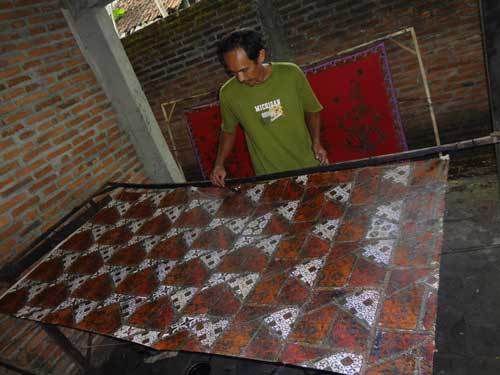
Original batik fabric design from indonesia. rich motif and colorfull
March 29 2017
I have been having a love affair with exotic textiles most of my life, in other words ever since I lived in the Far East as a young and impressionable female in the mid 60's. Malaysia specifically. And the textiles were the most breathtaking batiks worn by the standard Malaysian women of time. At the time I only knew that I'd fallen in love with their marvellous prints, the diversity of which appeared infinite. The real fabric was cotton and came in 2 x 1 metre lengths which are actually sewn to form a tube. These were worn as simple sarongs with a blouse the very top. But the 2 most striking things about these incredible materials were the strong colours and configurations. These have stayed with me over all the intervening years.
In those years I managed to find an impressive chain of shops in England named Anokkhi. They offered wonderful and original prints from India. Clothing weren't inexpensive by any means, but much of this profits were ploughed into the villages in India that produced such delightful wearables. The textiles themselves were made from the most sensual soft Indian cotton, sadly no longer you can get today due to the stringent Health and Safety regulations prevalent in the western. They could not be fire proofed so sadly we now have to use the more conventional fire proofed cotton. But incredible original designs are still being used. These are prints cut into wood blocks, several of will be several hundred years unused.

Imagine my surprise and delight when after obviously Thailand for over an I discover, of all places, a road-side night market selling the same batiks of forty in the past. To my delight they still came within 2 x 1 metre lengths or tubes, while still in the most amazing patterns and colours. I'd spent two of last 3 years trying get unusual or original patterns of Thai, Malay or Indian origin, but without results. So to discover my ancient batiks in this little market was nothing short for a miracle. A small research and a few books later and the mystery and history of batiks was solved. They did indeed originate in India, travelling to Indonesia inside of the fifteenth century with the migration of groups of Indian people southwards.
The colours and designs are incredibly beautiful and will be so vivid with their never ending dot patterns, many of which tell a story. In past certain patterns and colours could only be worn by Royalty or extremely wealthy. Today batiks aren't made by the traditional wax and dye methods, which weren't only mind-numbing but very expensive, are usually printed. However, if you'll need a traditionally made batik they can still be which will order, but at an amount of course.
Sadly, my source of batiks here in Thailand never seems to have an one pattern the exact same. Once in that shop I am totally mesmerised by the sheer degree of the different patterns and colors and invariably lose all sense of logic after i delve through these brilliant works of art. When by chance I think I've found the similar pattern, closer inspection shows a difference. This cause batiks so splendidly enjoyable. And the chances of anyone wearing the similar batik clothes as you might be very remote, so it is remain an unique bureau.
Finally, during a holiday to Indonesia, I found that having quality batik world with a blend of beauty of painting and great quality fabric also.I visited some cities in Indonesia is very famous as producers of baju batik such as jogjakarta and pekalongan city, creating their produce more well-known as batik pekalongan and batik jogja.